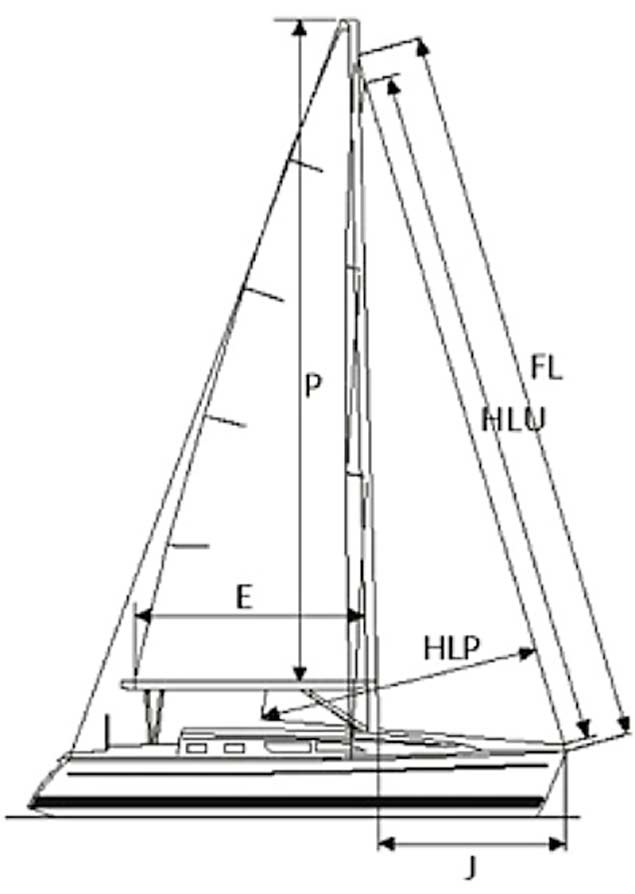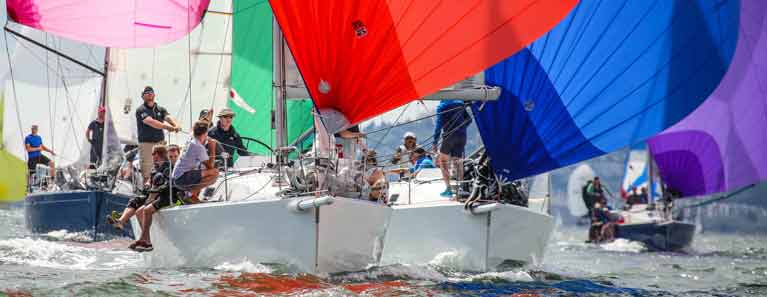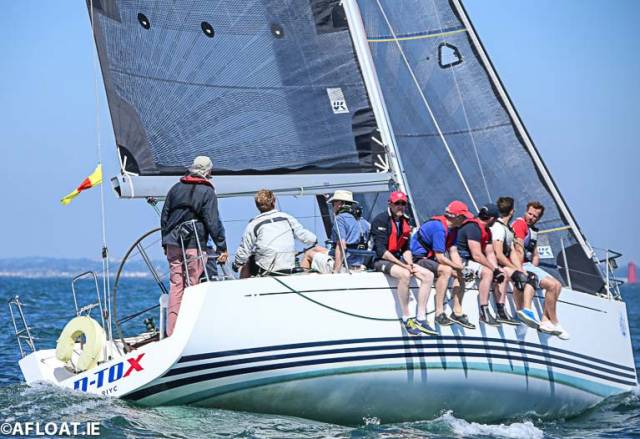IRC is an ever-changing rule, adapting as our sport evolves at both the Grand Prix and club racing level. At UK Sailmakers Ireland we are always searching for advantageous gains for our customers. With a new year comes an amended IRC rule. Below we go through some of the changes of note (full details available from the IRC website) and give some advice on how to take full advantage of the rules without finding yourself on the wrong side of them.
Links for referenced documents for ease of use:
2019 IRC Rules and Definitions
Racing Rules of Sailing 2017-2020
World Sailing Offshore Special Regulations
IRC 2019 – Spinnaker allowance
The IRC rule rates every boat with an assumed number of three spinnakers on board while racing. Should a boat wish to carry a forth spinnaker, a particularly popular option for offshore races, there is a penalty (usually one point) applied to their IRC rating.
Under the 2019 rule, a boat may declare that they only carry two spinnakers aboard while racing for a rating reduction (assumed to be one point).
Currently IRC Rule 21.6.1 describes how boats will be rated for carrying more than three spinnakers on board. The rule does not explicitly state that they should not carry more spinnakers than declared on their certificate. In addition, whilst three spinnakers is generally considered to be a minimum number for boats competitively racing, it does not consider that a significant number of club level boats only use 1 or 2 spinnakers. Feedback from the owners of these boats shows that they feel at a disadvantage as they have a reduced sail inventory and are not able to compete. To encourage boats within this sector of the fleet it is proposed to allow boats to declare that they will carry a number of spinnakers less than 3. This will open up the possibility for the technical committee to consider a rating decrease for either 1 or 2 spinnakers on that basis.
Rule 21.6.1
2018: Boat carrying more than three spinnakers in total on board while racing will incur an increase in rating.
2019: Boats shall not carry on board more than the number of spinnakers on their IRC certificate while racing.
This change makes it clear that the maximum number of spinnakers that shall be on board while racing is as per your IRC certificate. It also allows a boat to consider an advantageous rating decrease for using less than 3 spinnakers. If you wish to change the number of a spinnaker on your certificate you can do so on your 2019 revalidation after having your sails remeasured in our IHC approved sail loft.
With the above in mind it is also important to consider rule 21.1.5.d:
(d) During a regatta run on consecutive days, including any lay days, the sails on board shall remain the same and be on board for all races. This Rule may be amended by Notice of Race.
You could have five spinnakers to choose from for a week-long event but the sails you use for day one must be the same sails used on day five. Hot swapping sails depending on the day's conditions is not allowed – unless explicitly stated in the event Notice of Race or Sailing Instructions. If you damage a sail beyond repair consider point f:
(f) exceptionally, in the case of significant damage or loss, sails may be replaced with similar sails. A Notice of Race may require that boats obtain permission from the Race Committee before replacing a sail. This Rule may be amended by Notice of Race.

Crew Positions & Lifeline Deflection
Hiking is extremely effective in terms of generating righting moment and boat speed. According to Farr Yacht Design; in general terms, crew weight hiking is approximately 1.45 X as effective as bulb weight, so adding one 80 kg crew member is similar to 116 kg on the bulb. This means that crew weight is more “efficient” when considering righting moment versus displacement. As such it is important to clearly define what constitutes hiking and what doesn’t.
22.6.1 RRS 49.2 is modified by deleting “sitting on the deck” in the second sentence.
The IRC rule change removes the ambiguous term “sitting on the deck” while maintaining the original intention of:
- When there are two lifelines, competitor facing outboard with their waist inside the lower lifeline may have the upper part of his body outside the upper lifeline.
- Lifelines shall be taut (by the OSR definition).
With hiking now clearly defined – what exactly is a ‘taut’ lifeline?
This is a point which raises some debate – likely due to the digging required to actually find the definition.
Loose lifelines are a major advantage when hiking. It allows more bodies to project further outboard, increasing righting moment as a result. Having the lifelines as loose as possible, without breaking the rules, is critical. So what is the definition of taut?
Lifeline deflection specified in the Offshore Special Regulation 3.14.1.i is as follows:
- When a deflecting force of 4 kg (8.8 #) is applied to a lifeline at the midpoint of the longest span between supports that are aft of the mast, the deflection shall not exceed:
- 50 mm (2”) for an upper or single lifeline
- 120 mm (4 ¾”) for an intermediate lifeline
So when a 4kg weight is applied to a lifeline it must not be deflected more than 120mm from the straight line between its two support stanchions. This should be done between the two stanchions aft of the mast with the greatest distance between them ie. The longest part of the wire.
There are some, shall we say, creative solutions to bypassing this rule. These are under investigation by rating/rules authorities to determine their legality.
With equipment inspections likely to become more common in Irish sailing, in the interest of fairness, it is best to be within the OSR lifeline definitions. The looser the better for hiking – but not so loose that you land yourself in hot water!
P & E Definitions – Confirm your black bands!

A boat’s P is the maximum allowable mainsail luff length. A boat’s E is the maximum allowable mainsail foot length. These are generally known as your “black bands”. The 2019 IRC rule clarifies the definition of both measurements. This is for the benefit of measurers and sailmakers rather than the sailor. However, what is of particular interest to the sailor is that if there are no black bands on the mast or boom then the extremities of the spars will be measured.
P: “If there is no upper limit mark (black band) the upper measurement point shall be taken as the top of the highest sheave used for the halyard.”
E: “If there is no outer limit mark the outer measurement point shall be taken to the aft end of the boom.”
Check your black bands versus your certificate and sails. If they are not marked already be sure to do it to avoid being caught out at a later stage. If you sails are smaller than your defined black bands you may be able to reduce your P & E measurement for a rating advantage.
Remember – your P & E measurements come from your mast, they are not measured from your mainsail. Mainsails are built to be within the bands. The bands define the mainsail, the mainsail does not define the bands.
STL Measurement – How long is your pole?
Similar to the P&E definitions above – the STL definition has been amended to improve clarity.
IRC definition STL addresses horizontal spinnaker tack point distance from the mast. The current rule does not make it clear that the spinnaker pole track and any fittings to the mast should be ignored in the measurement of STL. The current rule does not make it clear that bowsprit outer limit marks should be ignored in the measurement of STL.
It is therefore proposed to amend IRC definition STL to make it clear that fittings on the mast and bowsprit outer limit marks are ignored when measuring STL.
 Amend STL definition as follows:
Amend STL definition as follows:
The greatest horizontal distance from the forward face of the mast spar, ignoring any fittings and tracks, measured on or near the centreline of the boat, to any of the following:
- the extremity of the spinnaker pole, whisker pole or bowsprit, ignoring any outer limit marks;
- the spinnaker tack point on deck projected vertically as necessary;
- if a headsail may be tacked forward of the forestay, the headsail tack point on deck projected vertically as necessary or to the extremity of the bowsprit.

The pole track and any fittings at the mast are ignored when measuring a boats STL. So your STL is clearly defined as the measurement from the front face of your mast to the outmost extremity of the pole, rather than the length of the pole itself. This is worth checking to ensure your certificate is accurate.
Single Furling Headsails
The definition wording for furling headsail has been updated to ensure the rule is restrictive as intended.
IRC rule 21.8.1(c) defines how a furling headsail is used. In the rule restricting the use of headsail to be not less than 95% of HSA there is a permissive “may” when the rule actually requires a restrictive “shall”.
Amend Rule 21.8.1(c) as follows:
Only a single headsail shall be used while racing, whose HSA may shall not be less than 95% of rated HSA except that alternatively a storm jib (see Appendix 1) may be used.
The change makes it clear that using a furling headsail of not less than 95% of the rated HSA is a requirement.
Other Changes and Clarifications
The remaining changes for the 2019 IRC rule are general clarifications on definitions or additional rules for Grand Prix racers. For example – a rule has been added to rate all boats with systems to adjust their forestay’s while racing. There was also a small change in the rig factor definition for clarity and to better reflect current rating practices.
Conclusion
Staying up to date with the IRC rule is critical for optimum performance at our national regattas. The offseason is the perfect time to confirm and check measurements, tinker with lifeline tension, and renewing your sail measurements to ensure you are being fairly rated. Do all of this and you will be ready to hit the ground running come Spring.
As always our doors, phones, and email are always open to offer advice and guidance.



























































